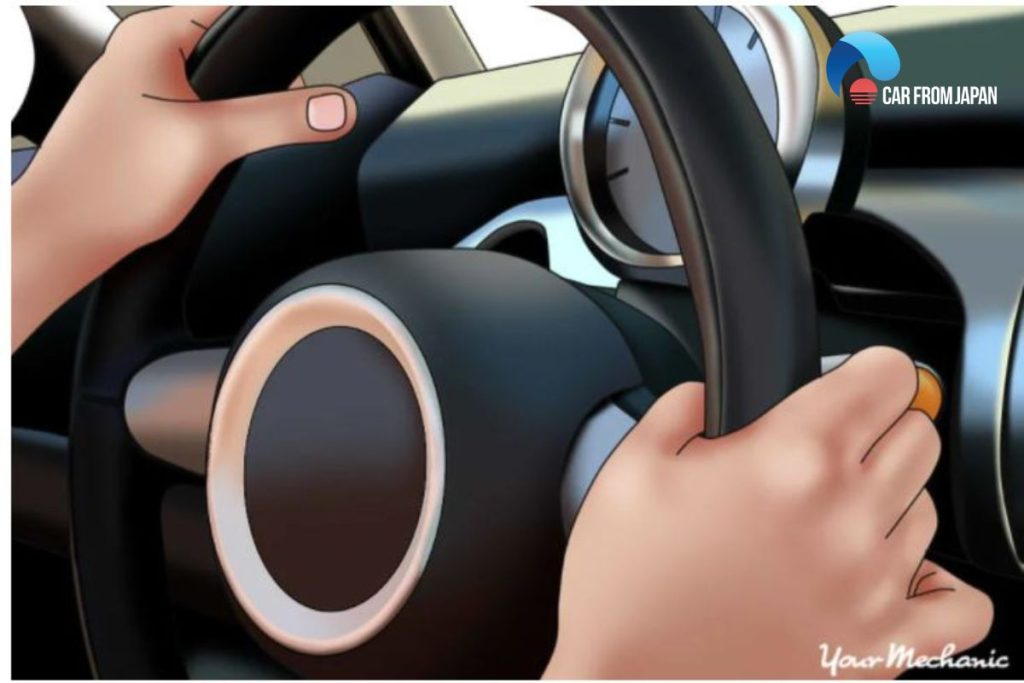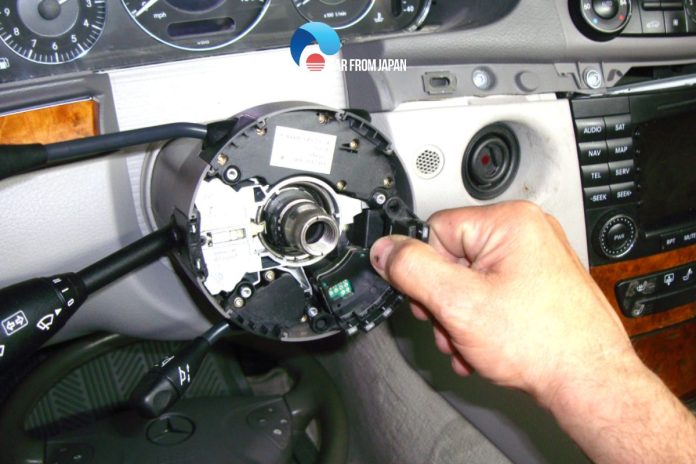If you find yourself in a situation where you need to reset the steering angle sensor but don’t have a scanner available, fear not!
In this guide, we will walk you through a step-by-step process to guide you on how to reset steering angle sensor without scanner!
Contents
- What Is A Steering Angle Sensor?
- What Happens When A Steering Angle Sensor Goes Bad?
- How To Reset Steering Angle Sensor Without Scanner?
- Can You Drive With A Bad Steering Angle Sensor?
- FAQs on Resetting Steering Angle Sensor Without Scanner
- Can I reset the steering angle sensor by simply turning the wheel lock-to-lock?
- Does disconnecting the battery reset the steering angle sensor?
- Why does the traction control light stay on after I reset the steering angle sensor?
- Is it safe to drive with an uncalibrated steering angle sensor if the car still steers fine?
- Can I use the dashboard button combinations to reset the sensor?
- Conclusion
What Is A Steering Angle Sensor?
The steering angle sensor (SAS) is responsible for providing information about the rotation speed of the steering wheel, sending signals to the car’s control system to determine the turning direction.
The steering angle sensor uses different voltages to obtain information about the angle and direction of rotation and then sends this signal to the ECU so that the system knows which direction the driver wants the car to move.
At this point, the ECU utilizes an algorithm to align the steering wheel with the wheels, ensuring the accurate steering angle and direction.
This principle assists the vehicle in avoiding unexpected obstacles and achieving balance in hazardous cornering situations.
Talking about the operating principle, as we mentioned, the SAS is an electronic device that measures the steering angle and sends a voltage signal to the electronic stability control (ESC).
When the system receives information from the sensor, an automatic algorithm calculates the gear ratio between the steering angles to ensure that the steering angle control operates normally.
It’s clear that the steering angle sensor (SAS) plays a crucial role in modern vehicles, providing important data to various safety systems such as Electronic Stability Control (ESC) and Anti-lock Braking systems (ABS).
So what will happen to your car if this sensor is damaged?

What Happens When A Steering Angle Sensor Goes Bad?
Despite being manufactured using modern technology and being installed in a location with minimal exposure to dust, the steering angle sensor (SAS) can still sustain damage.
As a result, it is essential for car owners to pay attention to certain signs that may indicate the need for timely intervention.
Electronic stability control light on
One of the primary functions of the SAS is to provide data to the vehicle’s stability control system.
The ESC system uses information sent from rotation angle sensors, speed sensors as well and acceleration sensors to detect steering movements of the steering wheel, helping the vehicle move in the right direction.
Therefore, when the steering angle sensor is faulty or no longer able to collect information, the signal sent to the ECU will be inaccurate.
At this time, error codes will be sent directly to the engine control module, the indicator light will immediately light up to warn the operator.
Inaccurate steering wheel alignment
A malfunctioning SAS may cause the steering wheel to be misaligned even when driving straight. You may notice that the steering wheel is off-center or tilted to one side while driving in a straight line.
Unresponsive and strange steering
A bad steering angle sensor can result in awkward or unpredictable steering behavior. You may experience sudden changes in steering response or find it challenging to maintain a steady course while driving.
Warning lights on the car dashboard
In some cases, a malfunctioning SAS can trigger warning lights on the instrument panel, such as the Check Engine Light or the Airbag Warning Light.
These lights may indicate a broader issue related to the vehicle’s electronic systems but can be influenced by the SAS malfunction.
Lacking power steering
Limited functionality of driver-assistance systems: The SAS is crucial for various driver-assistance systems, including lane departure warning, adaptive cruise control, and collision avoidance.
If the steering angle sensor is malfunctioning, these systems may not function correctly or may not engage at all.
Read More: Steering Wheel Hard To Turn: 6 Reasons & Solutions

How To Reset Steering Angle Sensor Without Scanner?
Generally, the steering angle sensor needs to be reset or calibrated after the steering system components have been aligned or replaced.
For example: the steering wheel, airbag spring, steering column, etc. Or in other situations like the stability control and traction control system malfunctioning or after a steering-related repair.
So if you want to save money on this process, let’s learn how to reset your steering angle sensor without a scanner with our easy DIY guide in this part.
Step 1
Turn off the engine and remove the key from the ignition.
Step 2
Locate the steering angle sensor. It is usually located near the steering column or integrated into the steering rack.
Step 3
Disconnect the battery cables. Start by disconnecting the negative (black) cable first, followed by the positive (red) cable. This step is important to ensure safety and prevent any electrical issues.
Step 5
Wait for at least 15 minutes to allow the vehicle’s electrical system to discharge completely.
While waiting, turn the steering wheel fully to the left and hold it there for a few seconds, then turn it fully to the right and hold it there for a few seconds. This action helps to recalibrate the sensor’s neutral position.
Step 6
After the waiting period, reconnect the battery cables. Start by connecting the positive (red) cable first, followed by the negative (black) cable.
Step 7
Start the engine and turn the steering wheel from lock to lock a few times. This action helps the vehicle’s system recognize the steering angle sensor’s new position.
Once the setting process is complete, the vehicle should be kept stationary on a flat surface for 5 seconds or more.
Step 8
Take the vehicle for a test drive. Pay attention to the steering response and stability.
If the steering feels off or if any warning lights remain illuminated on the dashboard, it is recommended to have the vehicle inspected by a professional mechanic.
Watch this video from Auto Repair Guys to learn more about how to reset steering angle sensor!
Can You Drive With A Bad Steering Angle Sensor?
When the steering angle sensor is not functioning correctly, it can affect the accuracy of these systems, potentially compromising your vehicle’s overall stability and safety.
The sensor provides important information about the position and angle of the steering wheel, which is used by the vehicle’s electronic systems to make adjustments and interventions as necessary.
Driving with a bad steering angle sensor can lead to unpredictable handling, reduced stability, and potentially compromised braking performance.
It may also result in the malfunctioning of other safety features, such as the stability control system, which relies on accurate steering angle data. So it’s recommended you reset or replace this sensor timely to avoid unwanted risks.
Related Post: How to Clean 6 Different Types of Steering Wheel
FAQs on Resetting Steering Angle Sensor Without Scanner
Can I reset the steering angle sensor by simply turning the wheel lock-to-lock?
Yes, in some vehicles, turning the steering wheel fully left, then fully right, and then centering it while the engine is on can trigger an auto-relearn process.
Does disconnecting the battery reset the steering angle sensor?
Not always. While it may reset the ECU in some cars, most modern vehicles require a dynamic recalibration through movement rather than a hard reset.
Why does the traction control light stay on after I reset the steering angle sensor?
Even if the sensor is reset, the ECU may need to confirm alignment during a drive cycle.
Also, if the sensor is off-center, TCS or ESC will remain disabled.
Is it safe to drive with an uncalibrated steering angle sensor if the car still steers fine?
Not recommended. While steering may feel normal, safety systems like ESC and ABS may malfunction or overcorrect during emergency maneuvers.
Rarely!
A few vehicles (like some BMWs or Toyotas) have hidden button sequences (like holding the trip/reset button during startup) that initiate recalibration, but this is highly model-specific.
Conclusion
So here’s our notices on how to reset steering angle sensor without scanner.
We want to affirm that if your steering angle sensor is having problems, besides taking the car to a mechanic or any center repairs, resetting the sensor is one of the cases where the car owner can proactively make it by himself.
Now, you can get back on the road hassle-free! For more insightful Car maintenance tips, follow Car From Japan today!



